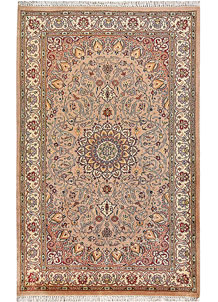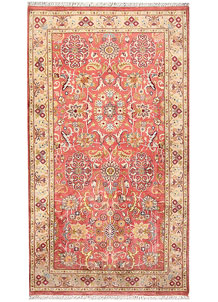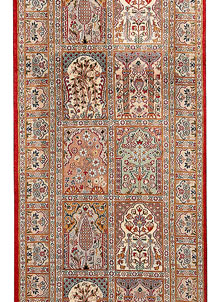Turkish Rugs
Turkish rugs, also known as Anatolian rugs, are handwoven textiles that have been made in Turkey for centuries. They are known for their intricate designs, vivid colors, and high-quality craftsmanship. One of the most famous styles of Turkish rugs is the Ottoman Court rug mostly Oushak, which was made during the reign of the Ottoman Empire. These rugs are known for their grandeur and often feature large, elaborate designs with intricate details.
Today, Turkish rugs are still highly prized around the world for their beauty, quality, and cultural significance. They are often used to add warmth and elegance to homes and other spaces, and can be a valuable investment for collectors and rug enthusiasts.
Rugs By Category: Turkish
88 results. Displaying 85 to 168.
History of Turkish Rugs
The history of Turkish rugs dates back to ancient times, with evidence of rug weaving in Turkey dating back to the 6th century BC. However, it was during the Seljuk period in the 11th and 12th centuries that the art of rug weaving in Turkey truly flourished.
The Seljuk Turks, who ruled over much of Central Asia and the Middle East during this time, were known for their love of luxury and their patronage of the arts. They brought with them the tradition of rug weaving from their homeland in Central Asia, and established workshops throughout their empire where skilled weavers could create beautiful and intricate rugs.
During the Ottoman period from the 14th to the early 20th century, the art of rug weaving in Turkey continued to flourish, with various regions and communities developing their own distinct styles and techniques. The Ottomans placed great importance on the production of fine textiles, and the royal court in particular commissioned many large and elaborate rugs that were considered works of art.
In the late 19th and early 20th centuries, Turkish rugs gained popularity in the West, with collectors and designers admiring their intricate designs, rich colors, and high-quality craftsmanship. Today, Turkish rugs are still highly prized around the world for their beauty, quality, and cultural significance.
Types of Turkish Rugs
There are many different types of Turkish rugs, each with its own unique style, design, and history. Some of the most well-known types of Turkish rugs include:
- Anatolian Rugs: These are rugs that are made in the Anatolian region of Turkey, which includes areas such as Konya, Kayseri, and Sivas. Anatolian rugs are known for their bold colors and geometric designs.
- Oushak Rugs: These are rugs that are made in the town of Oushak, located in western Turkey. Oushak rugs are known for their soft, muted colors and large-scale, floral designs.
- Hereke Rugs: These are rugs that are made in the town of Hereke, located near Istanbul. Hereke rugs are known for their intricate designs and high-quality craftsmanship.
- Kilim Rugs: These are flat-woven rugs that are made using a technique called kilim. Kilim rugs are known for their bright colors and bold geometric patterns.
- Cicim Rugs: These are embroidered rugs that are made using a technique called cicim. Cicim rugs are known for their colorful designs and intricate embroidery.
- Sumak Rugs: These are flat-woven rugs that are made using a technique called sumak. Sumak rugs are known for their bold colors and geometric patterns.
- Ladik Rugs: These are rugs that are made in the town of Ladik, located in central Turkey. Ladik rugs are known for their intricate designs and high-quality craftsmanship.
Why buy a Turkish rug?
Turkish rugs are known for their durability, high-quality materials, and intricate designs. Some of the benefits of Turkish rugs include:
- Durability: Turkish rugs are made with high-quality materials, which makes them durable and long-lasting. They can withstand heavy foot traffic and are resistant to wear and tear.
- Style: Turkish rugs are available in a variety of styles and designs, from traditional to modern. They can add elegance and sophistication to any room in your home.
- Craftsmanship: Turkish rugs are hand-woven by skilled artisans, who use traditional techniques that have been passed down for generations. The level of craftsmanship that goes into each rug is evident in the intricate designs and high-quality materials used.
- Investment: Turkish rugs are often considered an investment, as they can appreciate in value over time. Antique and vintage Turkish rugs, in particular, can be highly sought after and valuable.
- Versatility: Turkish rugs can be used in a variety of settings, from formal living rooms to casual family rooms. They can be used as a focal point in a room or as a subtle accent piece.
- Comfort: Turkish rugs are often made with natural materials, such as wool or silk, which makes them soft and comfortable underfoot. They can add warmth and coziness to any space.
Frequently Asked Questions
Q. How much are Turkish rugs in Istanbul?
The price of Turkish rugs in Istanbul can vary widely depending on factors such as size, material, design complexity, and quality of the weave. Additionally, bargaining is a common practice in Turkey, particularly in traditional bazaars like the Grand Bazaar in Istanbul. As such, it can be difficult to provide a precise answer to this question.
However, to give a general idea, small and medium-sized Turkish rugs can range from a few hundred to a few thousand US dollars, while larger and more elaborate pieces can be significantly more expensive. It's always a good idea to do some research and have a general sense of what you are willing to pay before entering into negotiations.
Q. How to clean a Turkish rug?
Cleaning a Turkish rug can be a delicate process, as these rugs are often made from natural fibers and dyes that require special care. Here are some general steps to follow when cleaning a Turkish rug:
- Vacuum the rug thoroughly on both sides to remove loose dirt and dust. Use a low setting on your vacuum cleaner and avoid using the beater bar, as this can damage the rug's fibers.
- Test for colorfastness by dabbing a small, inconspicuous area of the rug with a damp cloth. If the colors bleed or fade, do not proceed with further cleaning.
- Spot-clean any stains with a mixture of warm water and a mild detergent. Use a clean cloth or sponge to apply the solution to the affected area, then blot with a dry cloth to remove excess moisture.
- Wash the rug with a mild soap and cool water. Do not use hot water or harsh detergents, as these can damage the rug's fibers and colors.
- Rinse the rug thoroughly with cool water to remove all soap residue.
- Squeeze out excess water from the rug using a clean towel, being careful not to wring or twist the rug.
- Hang the rug to dry in a well-ventilated area, away from direct sunlight.
- Once the rug is dry, brush the pile gently with a soft-bristled brush to restore its texture and shape.
Note that if you are unsure about cleaning your Turkish rug yourself, it is always best to consult a professional rug cleaner who has experience with this type of rug.
Q. How can you tell if a Turkish rug is real?
Authentic Turkish rugs are known for their unique designs, quality materials, and skilled craftsmanship. Here are a few ways to tell if a Turkish rug is real:
- Look at the materials: Real Turkish rugs are made from natural materials like wool, silk, and cotton. Synthetic materials like polyester and nylon are not used in traditional Turkish rug making.
- Examine the knots: Turkish rugs are hand-knotted, and the density of the knots is a good indicator of the rug's quality. The more knots per square inch, the better the quality.
- Check the back of the rug: The back of an authentic Turkish rug will be almost as beautiful as the front, with clear and defined designs and a tight weave.
- Look for imperfections: Traditional Turkish rugs are handmade, so there may be small imperfections in the design or weaving. If a rug looks too perfect, it may be machine-made.
- Do your research: If you're still unsure about the authenticity of a Turkish rug, do some research on the seller or manufacturer. Look for reputable dealers and check for certifications or guarantees of authenticity. Qaleen provides certificate of authenticity with all our Turkish rugs.
Q. Why are Turkish rugs so expensive?
Turkish rugs are often expensive because they are handcrafted by skilled artisans using high-quality materials such as wool or silk. The process of making a Turkish rug can be time-consuming and intricate, with each knot being tied by hand. Additionally, Turkish rugs are often considered valuable because they are often woven in traditional designs and patterns that have been passed down through generations of weavers. The reputation of Turkish rugs has also contributed to their high value, as they are often seen as a symbol of luxury and quality. Finally, the demand for Turkish rugs in the global market has increased their prices, especially for rare or antique pieces.













